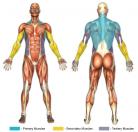One-Arm Rows / Bent-Over Rows (Dumbbell)
- Place a dumbbell on the floor to the right of a flat bench.
- Position your left knee and left foot on the bench so that your lower leg is horizontal with the ground, and place your right foot flat on ground with a slight bend in the knee.
- Place your left hand on the bench far enough in front of your left knee so that your back can assume a neutral, straight posture.
- Keeping your left knee and left arm on the bench, reach down and grab the dumbbell with your right hand in a neutral grip (i.e. palm facing in).
- Pull the dumbbell upward as high as possible, briefly squeezing your back at the pinnacle of the row, while exhaling throughout the movement. Be sure to keep the dumbbell next to your body.
- Lower the dumbbell back down. Your arm should be straight at the end of each repetition, but the dumbbell should not be touching the ground.
- Repeat steps 5-6 for as many repetitions as desired.
- When one side is completed, place the dumbbell on the other side of the bench and repeat steps 2-7 for the opposite side without resting. Note: Ideally you should begin each set of rows with your weak side.
The weight should be pulled straight up, not to the outside or in towards the body.
If your shoes are dirty, rather than placing your foot directly on the bench, instead allow it to hang off the edge. In this manner your shin can be used in conjunction with your knee for stability, and you won't sully up the bench.
As dumbbell rows utilize the powerful back muscles, a large amount of weight can be lifted when performing this exercise. Caution should be taken to prevent injury to the elbows and wrists of the stabilizer arm when lifting with hefty weight amounts.
This exercise owns a propensity for proper form to be broken easily, and as such control must be maintained to optimize workout efforts. The rowing form for this exercise should be deliberate and controlled, and thus should not represent the sort of rowing one often sees when a lawn mower is being started. If one is unable to lift the dumbbell fully to the body, then either lighten the load or do partial reps but do not resort to heaving (where the hips rotate, for instance).





